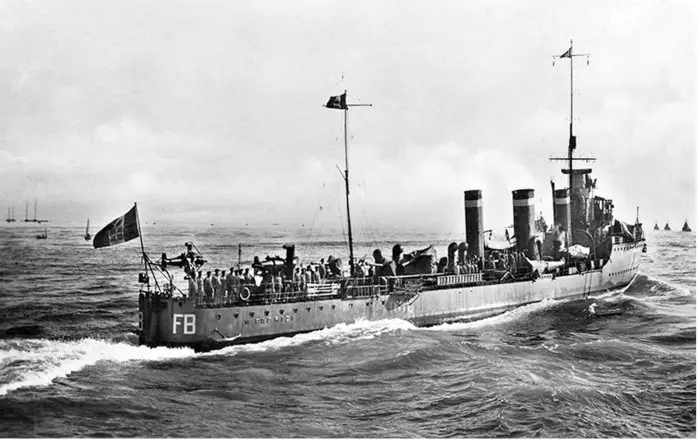
A mostly overlooked, but strategically relevant clash in the strait of Otranto, happening the same night of the Taranto raid.
The mission of Force X
On the 11th of November 1940, the British Mediterranean fleet was at sea for a complex operation (M.B.8), which included the planned raid against the Italian fleet at Taranto (Operation Judgement). As part of this complex plan, at 13:10, Force X, a group of three cruisers (HMS Orion, Ajax and HMAS Sydney) escorted by two destroyers (HMS Mohawk and Nubian) detached from the main fleet and headed for the Adriatic Sea. Their mission was to harass the enemy convoy routes between Southern Italy and Albania. By this time the Italians were in fact very busy with their campaign against Greece, and troops and supplies were travelling daily on those routes.
Force X had to approach the area with the cover of darkness, sail for a while into the Adriatic after midnight and then turn southwards in order to link up with the rest of the Mediterranean Sea the next morning near the island of Kefalonia. Force X proceeded as planned and did not encounter any Italian ships along their way. However, when they turned southwards, at 01:10 they sighted something on the horizon, in a night illuminated by the moon.
The action
Force X had just come across a convoy of four Italian merchant ships that were on their way back from Valona to Brindisi. The four merchant ships (Catalani, Locatelli, Premuda, Capo Vado) were escorted by the old torpedo boat Fabrizi and the auxiliary cruiser Ramb III. The four merchant ships proceeded in a column, with Fabrizi on the left and Ramb III on the right.
The two opposing forces sighted each other almost at the same moment. Force X closed in to intercept the Italian formation. On the opposing side, Captain Giovanni Barbini, on the Fabrizi, ordered to increase speed and head towards the approaching ships. Between 01:25 and 01:28 both sides opened fire when the range had decreased to distances between 3,500 and 5,700 meters. Heavy British fire invested the Italian merchant ships, which tried to evade by turning to the right. One by one they caught fire and sunk. Also, the Fabrizi received hits on board, trying to return fire with her forward 102mm guns. At some point, the ship manoeuvred to launch torpedoes but a hit onboard had damaged cables and other systems that prevented her to release the weapons. The Fabrizi then tried to hide the merchant ships with a smoke screen, while turning right in the same direction as the convoy, but it was too late. Captain Barbini was also wounded in his leg but maintained his command post on the damaged ship while she returned fire. In the meantime, the Ramb III had fired some 120mm shots against the enemy ships but then her Captain ordered to turn away and evade the ensuing massacre.

The Torpedo boat Fabrizi

The cruiser HMAS Sydney
All four merchant ships sunk in succession while the Ramb III evaded in time and later reached Bari. The Fabrizi, although heavily damaged, reached Valona. At 01:55 Force X turned southwards to exit the Adriatic and re-joined the Mediterranean Fleet during the morning. In the following hours, two Italian torpedo boats departed from Valona (Curtatone and Solferino) reached the area and rescued 140 survivors from the cold waters. Commander Barbini was awarded the Gold Medal for Military valour for his defiant action against the overwhelming enemy forces and for having saved his ship. On the other side, Captain Angelini, of the Ramb III, was deprived of his command and court-martialled for giving up the fight and abandoning (perhaps too early) the area. If Angelini had behaved differently, probably also the Ramb III would have sunk, given the odds against the Italians.

Map of the action in the Otranto strait
Consequences
The night action in the Otranto strait is overshadowed by the most famous raid on Taranto of that same night and thus receives a little degree of attention. However, its strategic consequences should not be overlooked. The action against the convoy brought the Italians to run convoys (between Valona and Italy), only in daylight and they strengthened the escorts, assigning 3 torpedo boats and 1 auxiliary cruiser for every 4 merchants. This decision inevitably drove away further light units to convoy escort duties, thus shrinking the ships available for implementing an effective blockade of the Sicilian channel, without mentioning the increase in fuel consumption.
If the Taranto raid did not affect the ability of the Regia Marina to venture at sea (see Operation White or Cape Spartivento) nor affected the safety of convoy routes to Libya, the clash in the Otranto strait increased the strain on Italian naval assets and consumption of resources.
Sources
Fioravanzo, G. (1959). La Marina Italiana nella seconda guerra mondiale, Volume II La Guerra nel Mediterraneo: le azioni navali (Tomo 1). Roma: USMM.
Giorgerini, G. (2001). La Guerra Italiana sul mare, La marina tra vittoria e sconfitta 1940-1943.
O’Hara, V. P. (2022). Lotta per il Mare di Mezzo. Roma: Ufficio Storico della Marina Militare.
Sadkovich, J. (1994). The Italian navy in World War II.